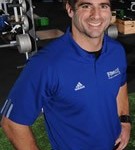Kettlebell Snatch For Young Athletes by Jason C Brown
Fitness for Kids: Pirates and 6-9-Year-Olds

I have referenced the “pirate game” several times in the past in the context of utilizing a fun game to provide several aspects of fitness to young athletes 6-9 years old. As a backdrop, we must remember that our programming for this age group must be rooted in body awareness/movement exploration, coordination, object manipulation, and game play/cooperation. By extension, when programming for young athletes, you need to approach things from a systemic standpoint while maximizing neural or bio-motor development.
Transition Game For Young Athletes
In this video Dave Jack shares a great Transition Game that he uses to help his young athletes make the transition from school or wherever else they may be coming in from into their training session. This is a superb way to get the young athletes focussed from their outside stressors. Young Athletes Transition Game
Why Performance Training Alone isn’t enough For Young Athletes

By Melissa Lambert Young athletes require more than physical training As a former collegiate athlete, I remember spending my off seasons training every opportunity I had including weight lifting, running and playing with the men’s team to increase my speed of play. I took pride in having the top times in running and physically being able to outplay others. However, I remember playing our rival team and making a huge mistake that could have resulted in the other team scoring. What could have possibly gone wrong when I was in the best shape of my life? I neglected the.. More »
High School Athletes Olympic Lifting Transition In 4 Steps

Transitioning to Power Cleans for High School Athletes in 4 simple Steps All of my athletes become very efficient at performing the Olympic lifts from the hang position, and I love that. This comes from a lot of practice but also from a very specific and well refined process for teaching and progressing the lifts in the hang position While I rarely ask my athletes to do Olympic lifts from the floor, I don’t however work in a vacuum and in many cases my high school athletes are training with their high school as well. This means that they.. More »
Whole-Part Coaching of the Hip Turn for young athletes
Young athletes hip turn whole-part coaching By Dave Gleason Coaching any exercise to Young Athletes can be challenging. One of the most effective methods is to break down an activity into its component parts, often times all the way down to the smallest or simplest part possible. This is very true when teaching the hip turn, especially to younger (10-13 year old) athletes. Unfolding this movement for Young Athletes in an effort teach them how and why hip/shoulder disassociation is crucial for their long term success. At Athletic Revolution we use a 1-2-3 method to take.. More »
Coaching a Large Group of Young Athletes in a Small Space

Young Athletes Programming in a Small Space By Dave Gleason At Athletic Revolution South Shore we have 2500 sq feet in total. Our usable space is approximately 1600 sq feet with an open turf area of only 1300 sq ft. We max out our session at 16-18 athletes per session. As the kids get older and can cover more ground quicker – it is imperative to prepare our programming with this in mind. Here are a few strategies that have worked extremely well for us as we program for our young athletes 6-18 years old. Staff – As skilled.. More »
Alternative Methods for Training Explosive Strength To High School Athletes

High School Athletes Strength Training By Wil Fleming Nearly all high school athletes, with very few exceptions, need to develop explosive strength. The instances in which the skill of explosive strength are used in sports are endless, but when used “explosiveness” is very apparent. A linemen firing off from their stance. A soccer player rising above his opponents to head a ball toward goal. A volleyball player making a quick lateral move to reach for the dig. Instances of explosive strength are very vivid when used and typically are a.. More »
Strength And Conditioning Coaches Misuse of Speed & Agility Training
Strength And Conditioning Coaches Often Overlook Movement By Jim Kielbaso A lot of people in this field call themselves Strength & Conditioning Coaches. I don’t have a problem with the “Strength” part of the title, but the “Conditioning” part could use a little work. As a former college S & C Coach, I fully understand the time constraints of the collegiate or high school environment. Running a private facility for athletes, I also understand the limitations of this situation. In both cases, it is very difficult to give every athlete the time and instruction they need. Still, there is.. More »
IYCA Member Spotlight: Melissa Lambert
IYCA Youth Fitness Specialist Spotlight I am licensed professional counselor in the state of Connecticut and work as a child and adolescent clinician at Natchaug Hospital. I graduated with a Bachelor’s degree in Psychology from Eastern Connecticut State University and was a four year collegiate soccer player earning All-Region and All-New England accolades as a defender. I completed my Master’s degree in Clinical Mental Health Counseling with a concentration in child and adolescent psychology at Springfield College. My experience includes working inpatient, partial hospital programs, in-home therapy for children and adolescents in crisis, facilitating parenting classes and writing.. More »
5 Steps To Getting In With Coaches
Coaches for high schools and teams need specialists… by Ryan Ketchum The biggest obstacle that arises with youth fitness and sports performance coaches and business owners seems to be figuring out a way to gain the approval and access to high school or team coaches. Honestly, 99% of you are probably doing it the wrong way. If you laid out your plan of attack (this is exactly how it will be taken by the coach) for working with the team or the coach’s athletes I would bet that for almost all of you it is being done the.. More »
‘Base Building’ for High School Athletes?
–> [wpfblike] High School Athletes coaching should focus on the five biomotor abilities. By Latif Thomas When my mother attended her first ever Parent-Teacher Conference, she expected Mrs. Candlette to tell her how smart I was. Or how polite I was. Or to hear about some other facet of my considerable six year old intellect… Instead, the first teacher to parent description to fall upon her ears was, “Wow, Latif sure can run fast!” What can I say? I owned Duck, Duck, Goose! So, when I arrived at the University of Connecticut, track and.. More »
Coaching Young Athletes : Use Feedback as Proprioception
[wpfblike] Brain Food for Coaching Young Athletes. by Phil Hueston, NASM-PES; IYCA-YFS Your feedback and communication is brain food when it comes to coaching young athletes. To develop correctly and effectively, young athlete’s brains need a steady flow of quality nutrients and stimuli. Neural development and conditioning is a process that never really ceases, at least not until brain function does. Since none of us train zombies, let’s focus on how we affect brain development, especially synaptic development, through communication, feedback and the impact of both on proprioception with our living clients. While synaptic structural.. More »
Training Young Athletes Where It All Begins
[wpfblike] Foot Strike: The most obvious but most overlooked component of training young athletes. About eight years ago, one of my high school high jumpers, Danielle, came running down to me at a track meet to tell me the news. As the coach of the long, triple and high jumps I was making the rounds at a meet trying to miss as few competitive attempts as possible, in a facility that spread the jump areas out. Needless to say, I missed her high jumps attempts. She was about to fill me in. Between spurts of.. More »
Coaching a Difficult Child
[wpfblike] by Melissa Lambert LPC, M.Ed, YFS1, YNS, HSSCS Child and Adolescent Therapist Child Coaching As a coach, you have taken the time necessary to prepare and structure practice ahead of time. You know everything from the theme of practice, whether it’s set plays in football or defense in soccer. You feel you know the sport inside and out, but are you ready to take on the child who rebels because there are no boundaries set at home or the child who is constantly talking over you due to poor impulse control? Current research estimates that 3 to 7.. More »
Combination Training for Power
[wpfblike] by Wil Fleming Both bands and medicine balls are great tools to develop power for athletes. When you combine them, though, you can get some really practical drills for athletes to use for total body power. Check out the video below to see a great drill I use to link the upper body and lower body in power creation.
Punch Cuts & Their Value In Developing Multi-Directional Speed
[wpfblike] By James Herrick Punch Cuts Every parent, coach and athlete involved in team sports realizes the importance of having speed. It gives players a distinct advantage over slower opponents. Although it is not the easiest skill to improve, with persistence players can clearly get better over time. It takes a combination of technical skill training, improved strength and power, and a lower percentage of excess body mass to see noticeable changes. There are literally thousands of videos, books, and drills out there today that proclaim they can help athletes build speed. But if you had to take just.. More »
Young Athletes – The Power of Recognition
[wpfblike] By Eric Cressey November is a big month if you train high school athletes, as this is when the overwhelming majority of athletes committed to play Division 1 sports sign National Letters of Intent to make it “official.” It’s an exciting day for the young athletes, their families, and their schools. I’ve been through five of these days since we opened Cressey Performance, and in retrospect, it’s really fun to see how many of those kids have gone on to successful college and, sometimes, professional careers. Young Athletes It’s also a time where I constantly remind myself and.. More »
A Pound of Prevention: There’s plenty you can do to steer clear of injuries.
[wpfblike] By Mike Mejia, CSCS Injuries & Prevention
mbbellKettlebell vs. Dumbbell
[wpfblike] By Jason C. Brown Kettlebell One of the most common questions I receive is “What’s the difference between and kettlebell and a dumbbell?” Quickly behind that question follows “Will kettlebell training carry-over into my activities of daily living more than training with dumbbells?” This is a hard topic to demonstrate via written word so I thought a short video would work best but I’ll give you quick low-down here as well. There is a distinct mechanical difference between a kettlebell and a dumbbell and it’s based on law of levers.
